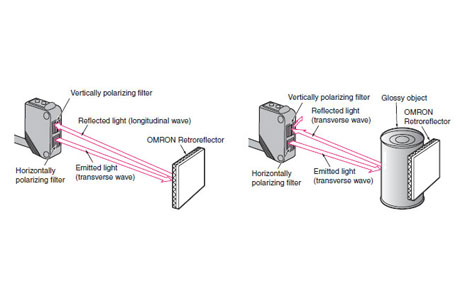Key Takeaway
Reflective sensors emit a light beam towards a target, which reflects the light back to the sensor. The light reflection scatters, making these sensors ideal for detecting general surface conditions.
Retroreflective sensors use materials like glass beads or prisms to reflect light directly back to its source. This design makes them more accurate and reliable, especially for longer distances. Retroreflective sensors are ideal in environments where background variations could affect detection.
How Reflective Sensors Work in Object Detection
Reflective sensors, also known as diffuse sensors, operate by emitting a light beam toward an object. When this light hits the object, it bounces back to the sensor’s receiver. The sensor detects the presence of an object by measuring the reflected light. These sensors are incredibly useful in situations where you don’t need to set up any additional hardware like reflectors or other gadgets.
One key aspect of reflective sensors is that they are sensitive to the object’s surface material. For example, if the object is shiny or metallic, the sensor will have a much easier time detecting it. On the flip side, if the object is dark or non-reflective, detection could be less accurate. Reflective sensors are quite versatile and ideal for applications such as counting objects on a conveyor belt. However, they might struggle with inconsistent surfaces, especially if the object is not uniformly reflective.

The Functionality of Retroreflective Sensors in Industrial Applications
Retroreflective sensors play a crucial role in industrial settings, especially where object materials vary. Unlike regular sensors, these devices use a reflector to detect objects, making them highly reliable. The sensor emits a light beam toward the reflector, which bounces back unless interrupted by an object. This system ensures that the sensor can detect even transparent or dark objects without fail. The reliability provided by the reflector is key in environments where surface conditions can’t be controlled.
For new engineers, understanding this concept is vital as retroreflective sensors help automate processes that involve diverse materials. Their performance remains consistent across challenging surfaces, ensuring smooth operation in warehouses or on production lines. Additionally, these sensors can detect objects over long distances, making them a staple in large-scale operations. The ability to handle various conditions with minimal errors is why retroreflective sensors are a go-to in industrial applications.
Differences in Performance Between Reflective and Retroreflective Sensors
When comparing reflective and retroreflective sensors, it’s essential to consider performance under different conditions. Reflective sensors, while simpler to install, can be sensitive to the reflectivity of the object’s surface. If the material is irregular or doesn’t reflect light well, the sensor might miss the object altogether. In contrast, retroreflective sensors, which rely on a reflector, maintain a higher detection accuracy across a variety of surfaces.
For engineers, this distinction highlights why retroreflective sensors are often the better choice for more complex setups. Though the additional installation of a reflector might seem cumbersome, the trade-off is worth it for consistent and reliable detection. In environments where accuracy is critical, such as in logistics or manufacturing, the reliability offered by retroreflective sensors outweighs their setup complexity.
Ideal Applications for Reflective Sensors
Reflective sensors are most effective in controlled environments where objects are close and have consistent reflectivity. These sensors excel in short-range detection, making them ideal for production lines where products are uniform in material, size, and shape. Packaging lines are a perfect example, where each product has predictable characteristics, allowing the sensors to perform optimally without any external interference.
Reflective sensors also fit well in spaces with limited room for additional hardware. Since they don’t need a separate reflector, they offer flexibility in cramped environments. For an engineer, knowing where reflective sensors thrive helps in selecting the right sensor for specific tasks. However, in cases where objects have varying textures or reflectivity, retroreflective sensors would be a more suitable choice.
Best Use Cases for Retroreflective Sensors
Retroreflective sensors shine in unpredictable environments, particularly where object surfaces are irregular or made from transparent materials. For example, in industries dealing with glass or plastic products, retroreflective sensors ensure that detection remains accurate regardless of material inconsistencies. The longer detection range further makes them suitable for environments like warehouses where objects are spread across larger areas.
Engineers working in logistics or manufacturing often choose retroreflective sensors for these reasons. In settings where speed and precision are crucial, these sensors provide the consistency needed for efficient operations. Whether it’s detecting pallets in a fast-moving warehouse or ensuring accurate vehicle positioning, retroreflective sensors are designed to handle the challenges posed by complex environments.
Conclusion
When choosing between reflective and retroreflective sensors, it’s essential to consider your application’s specific requirements. Reflective sensors are ideal for compact spaces with uniform materials, offering a straightforward setup. In contrast, retroreflective sensors excel in more complex environments, handling variable objects, greater distances, and ensuring reliable detection in high-traffic industrial settings. By selecting the right sensor based on your needs, you can enhance operational efficiency, minimize errors, and optimize your processes for better performance.
